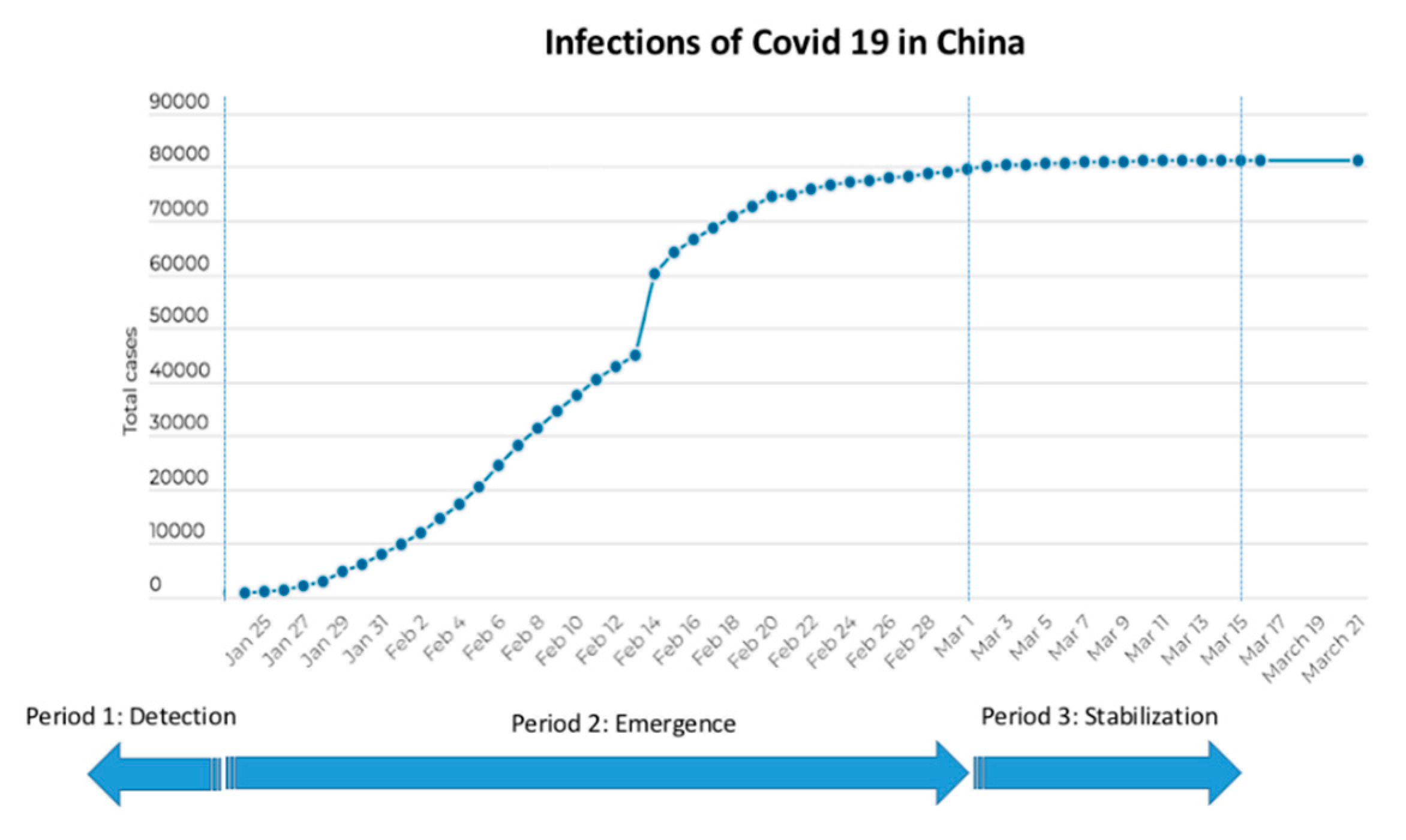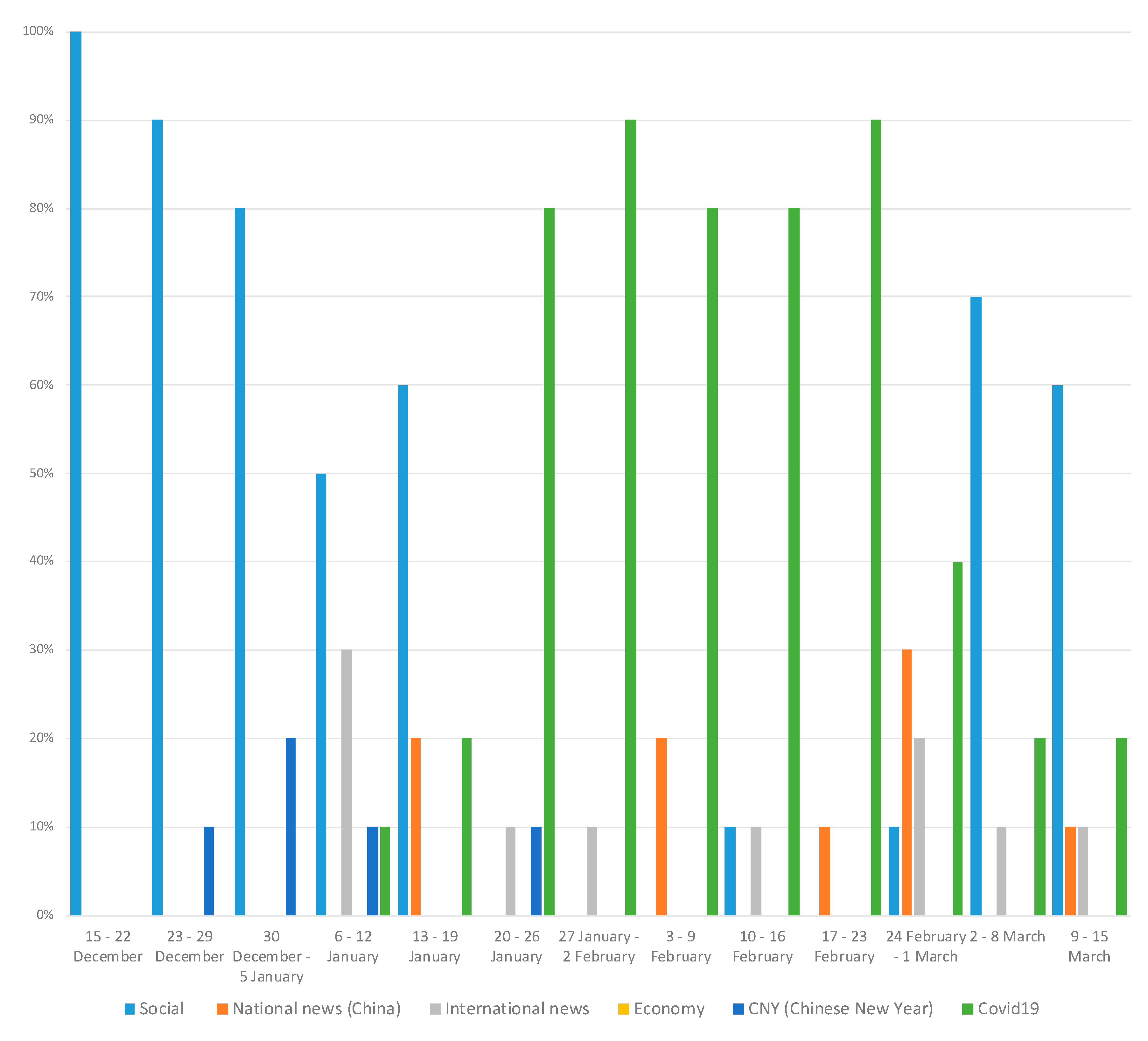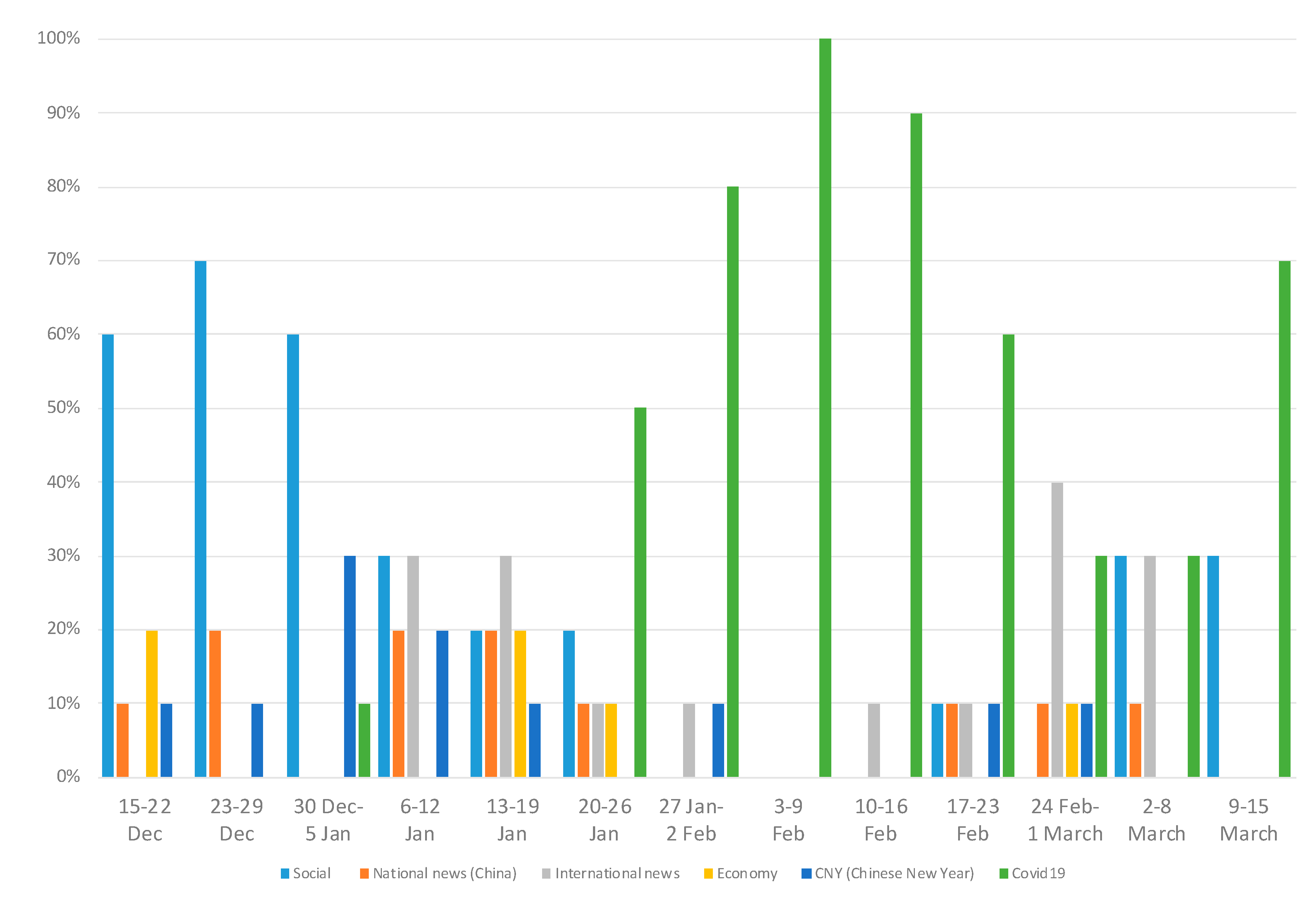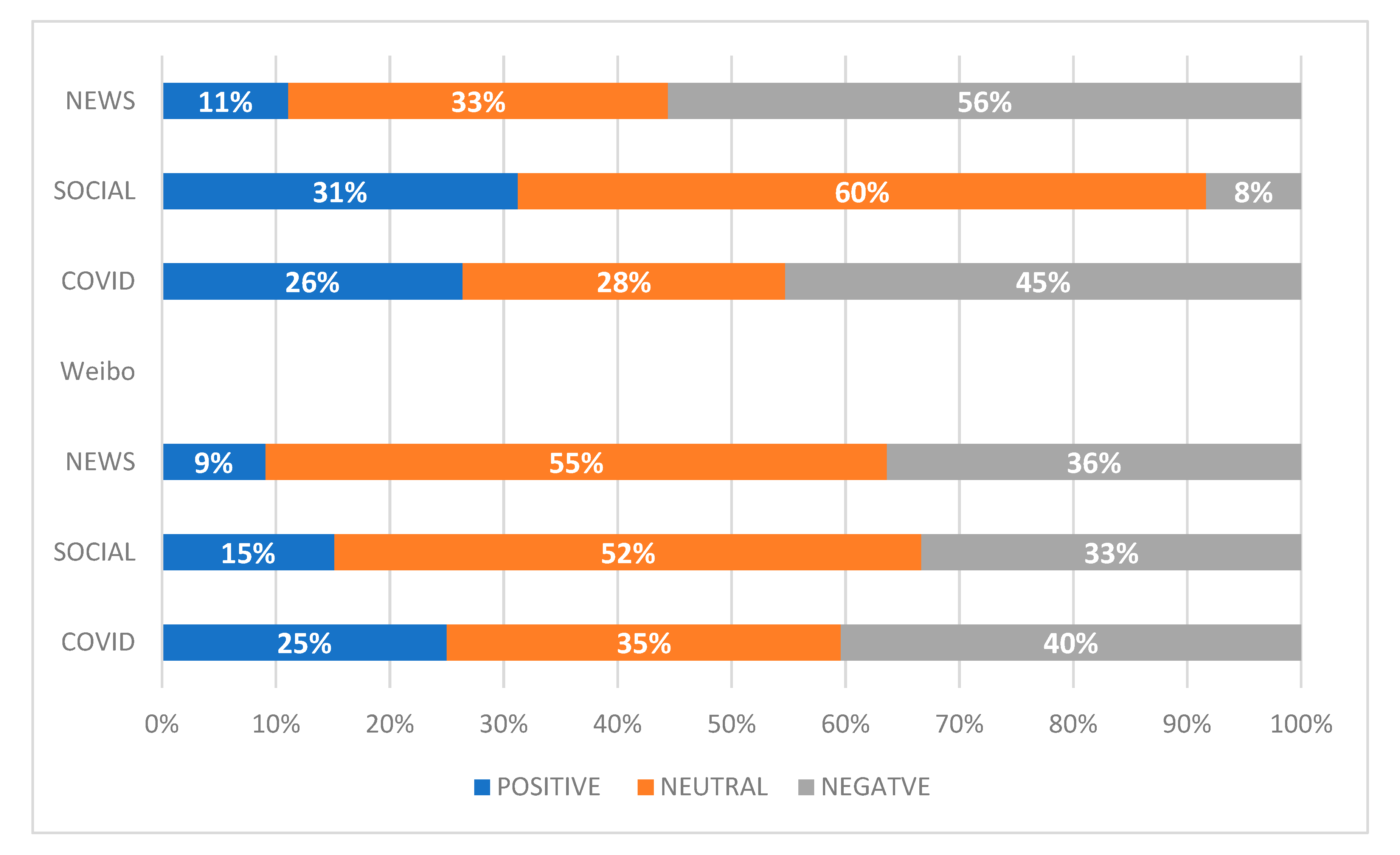Online Discourse in the Context of COVID-19, the First Health Crisis in China after the Advent of Mobile Social Media: A Content Analysis of China’s Weibo and Baidu
Abstract
1. Introduction
1.1. Usage of Internet and Social Networks in Chinese Society
1.2. Social Networks and Search Engines in the Face of Health Emergencies
2. Materials and Methods
- identify and categorise the topics of greatest interest published in Baidu and Weibo,
- analyse the content derived from searches and posts in Baidu and Weibo,
- conduct a sentiment analysis based on the topics searched and posted in Baidu and Weibo,
- compare the topics identified during the COVID-19 period in comparison to a non-COVID-19 period.
- Period 1: Detection of COVID-19 confirmed cases: 15 December to 5 January (500 or less cases confirmed).
- Period 2: Emergence and growth in COVID-19 confirmed cases: 6 January to 1 March (501–80,000 cases confirmed).
- Period 3: Stabilisation of COVID-19 confirmed cases: 2 March to 15 March (80.001–81.000 cases confirmed).
- Extra-period Non-COVID-19: August 2019 (0 cases confirmed).
- Social: Related to those topics that deal with social gossip and lifestyle facts and stories related to local Chinese celebrities and prominent leaders of opinion and politicians.
- National news: Includes those topics related to relevant information on social, cultural, political, and daily aspects of interest within China.
- International news: Includes those topics related to relevant information and activity on social, cultural, political, and daily aspects of interest originating from outside of China, on an international level.
- Economy: Related to topics in reference to the state of the economy in China.
- Chinese New Year (CNY): Relates to topics associated to the new year celebrations in China.
- COVID-19: Relates to topics associated to the coronavirus outbreak.
3. Results
3.1. Weibo Content Analysis
3.2. Baidu Content Analysis
3.3. Sentiment Analysis
- There was a higher occurrence of topics with negative sentiment related to COVID-19 published on both Baidu and Weibo when compared with social topics published during the same period on both platforms.
- There was a consistently higher level of neutral sentiment topics published on both Weibo and Baidu, in relation to social orientated information and general news topics, during the period of analysis of the investigation, in comparison with COVID-19 related topics on both online platforms, Weibo and Baidu.
- During the period of investigation, the results indicated a higher percentage of positive sentiment topics related to COVID in comparison to topics of general news orientation, for both Baidu and Weibo.
4. Discussion and Conclusions
Author Contributions
Funding
Conflicts of Interest
References
- Analysys. 2018. Available online: https://bit.ly/2xyXpHE (accessed on 9 May 2018).
- Analysys. 2020. Available online: https://bit.ly/2EE1CgX (accessed on 31 July 2020).
- Auer, Matthew, and King-wa Fu. 2015. Clearing the air: Investigating Weibo censorship in China: New research to show censorship of microbloggers who spoke out about pollution documentary. Index on Censorship 44: 76–79. [Google Scholar] [CrossRef]
- Benavides-Delgado, Juan. 2005. Nuevas propuestas para el análisis del lenguaje en los medios. Questiones Publicitarias 10: 13–33. [Google Scholar] [CrossRef][Green Version]
- Berelson, Bernard. 1952. Content Analysis in Communication Research. Glencoe: The Free Press. [Google Scholar]
- Business Insider. 2020. Available online: https://bit.ly/2UndSrA (accessed on 28 March 2020).
- Business of Apps. 2020. Available online: https://bit.ly/3bxYKxd (accessed on 24 March 2020).
- Cairns, Christopher, and Allen Carlson. 2016. Real-world islands in a social media sea: Nationalism and censorship on Weibo during the 2012 Diaoyu/Senkaku Crisis. The China Quarterly 225: 23–49. [Google Scholar] [CrossRef]
- Cheng, Yan. 2020. The social-mediated crisis communication research: Revisiting dialogue between organizations and publics in crises of China. Public Relations Review 46: 101769. [Google Scholar] [CrossRef] [PubMed]
- Chou, Wen-ying Sylvia, Yvonne M. Hunt, Ellen Burke Beckjord, Richard P. Moser, and Bradford W. Hesse. 2009. Social media use in the United States: Implications for health communication. Journal of Medical Internet Research 11: e48. [Google Scholar] [CrossRef]
- Confessore, Nicholas, Gabriel J. X. Dance, Richard Harris, and Mark Hansen. 2018. The Follower Factory. The New York Times. Available online: https://nyti.ms/30jkdar (accessed on 27 January 2020).
- Devex. 2020. Available online: https://bit.ly/2DpE4fe (accessed on 20 March 2020).
- Fu, King-wa, and Michael Chau. 2013. Reality check for the Chinese microblog space: A random sampling approach. PLoS ONE 8: e58356. [Google Scholar] [CrossRef]
- Fu, Jiawei Sophia, and Alice Y. L. Lee. 2016. Chinese journalists’ discursive Weibo practices in an extended journalistic sphere. Journalism Studies 17: 80–99. [Google Scholar] [CrossRef]
- Fung, Isaac Chun-Hai, King-Wa Fu, Chung-Hong Chan, Benedict Shing Bun Chan, Chi-Ngai Cheung, Thomas Abraham, and Zion Tsz Ho Tse. 2016. Social Media’s Initial Reaction to Information and Misinformation on Ebola, August 2014: Facts and Rumors. Public Health Reports 131: 461–73. [Google Scholar] [CrossRef]
- Gan, Chunmei. 2018. Gratifications for using social media: A comparative analysis of Sina Weibo and WeChat in China. Information Development 34: 139–47. [Google Scholar] [CrossRef]
- Garfin, Dana Rose, Roxane Cohen Silver, and E. Alison Holman. 2020. The Novel Coronavirus (COVID-2019) Outbreak: Amplification of Public Health Consequences by Media Exposure. Health Psychology 39: 355–57. [Google Scholar] [CrossRef]
- Han, Xi, Bei Li, Jiabin Qu, and Qinghua Zhu. 2018. Weibo friends with benefits for people live with HIV/AIDS? The implications of Weibo use for enacted social support, perceived social support and health outcomes. Social Science & Medicine 211: 157–63. [Google Scholar] [CrossRef]
- Hong, Traci. 2007. Information control in time of crisis: the framing of SARS in China-based newspapers and Internet sources. Cyberpsychology & Behavior 10: 696–99. [Google Scholar] [CrossRef]
- Hootsuite and We are Social. 2020. Available online: https://bit.ly/2QTzvxr (accessed on 20 March 2020).
- Hou, Juan, Yamikani Ndasauka, Xuefei Pan, Shuangyi Chen, Fei Xu, and Xiaochu Zhang. 2018. Weibo or WeChat? Assessing Preference for Social Networking Sites and Role of Personality Traits and Psychological Factors. Frontiers in Psychology 9: e545. [Google Scholar] [CrossRef]
- Hu, Yue, Jichang Zhao, and Junjie Wu. 2016. Emoticon-Based Ambivalent Expression: A Hidden Indicator for Unusual Behaviors in Weibo. PLoS ONE 11: e0147079. [Google Scholar] [CrossRef] [PubMed]
- Hua, Jinling, and Rajib Shaw. 2020. Corona Virus (COVID-19) “Infodemic” and Emerging Issues through a Data Lens: The Case of China. International Journal of Environmental Research and Public Health 17: 2309. [Google Scholar] [CrossRef] [PubMed]
- Huang, Ronggui, and Xiaoyi Sun. 2014. Weibo network, information diffusion and implications for collective action in China. Information, Communication & Society 17: 86–104. [Google Scholar] [CrossRef]
- Huang, Chunmei, Xinjie Xu, Yuyang Cai, Qinmin Ge, Guangwang Zeng, Xiaopan Li, Weide Zhang, Chen Ji, and Ling Yang. 2020. Mining the Characteristics of COVID-19 Patients in China: Analysis of Social Media Posts. Journal of Medical Internet Research 22: e19087. [Google Scholar] [CrossRef]
- Lee, Ji Young, and Shyam Sundar. 2013. To tweet or to retweet? That is the question for health professionals on twitter. Health Communication 28: 509–24. [Google Scholar] [CrossRef]
- Li, Weiguo, Jing Liao, Qinyuan Li, Muna Baskota, Xingmei Wang, Yuyi Tang, Qi Zhou, and Enmei Liu. 2020a. Public health education for parents during the outbreak of COVID-19: A rapid review. Annals of Translational Medicine 8: e628. [Google Scholar] [CrossRef]
- Li, Sijia, Yilin Wang, Jia Xue, Nan Zhao, and Tingshao Zhu. 2020b. The Impact of COVID-19 Epidemic Declaration on Psychological Consequences: A Study on Active Weibo Users. International Journal of Environmental Research and Public Health 17: 2032. [Google Scholar] [CrossRef]
- Lin, Xialing, Kenneth A. Lachlan, and Patric R. Spence. 2016. Exploring extreme events on social media: A comparison of user reposting/retweeting behaviors on Twitter and Weibo. Computers in Human Behavior 65: 576–81. [Google Scholar] [CrossRef]
- Liu, Brooke Fisher, and Sora Kim. 2011. How organizations framed the 2009 H1N1 pandemic via social and traditional media: Implications for US health communicators. Public Relations Review 37: 233–44. [Google Scholar] [CrossRef]
- Luqiu, Luewi Rose, Michael Schmierbach, and Yu-Leung Ng. 2019. Willingness to follow opinion leaders: A case study of Chinese Weibo. Computers in Human Behavior 101: 42–50. [Google Scholar] [CrossRef]
- Maher, Carol A., Lucy W. Lewis, Katia Ferrar, Simon Marshall, Ilse de-Bourdeaudhuij, and Corneel Vandelanotte. 2014. Are health behavior change interventions that use online social networks effective? A systematic review. Journal of Medical Internet Research 16: e40. [Google Scholar] [CrossRef] [PubMed]
- Muralidharan, Sidharth, Kristie Dillistone, and Jae-Hwa Shin. 2011. The gulf coast oil spill: Extending the theory of image restoration discourse to the realm of social media and beyond petroleum. Public Relations Review 37: 220–32. [Google Scholar] [CrossRef]
- Nguyen, Le T., Pang Wu, William Chan, Wei Peng, and Ying Zhang. 2012. Predicting collective sentiment dynamics from time-series social media. Paper presented at the First International Workshop on Issues of Sentiment Discovery and Opinion Mining, Beijing, China, August 12–16, vol. 6, pp. 1–8. [Google Scholar] [CrossRef]
- Nip, Joyce Y. M., and King-wa Fu. 2016. Challenging Official Propaganda? Public Opinion Leaders on Sina Weibo. China Quarterly 225: 122–44. [Google Scholar] [CrossRef]
- Niu, Lu, Dan Luo, Ying Liu, and Shuiyuan Xiao. 2016. The Accessibility, Usability, and Reliability of Chinese Web-Based Information on HIV/AIDS. International Journal of Environmental Research and Public Heatlh 13: 834. [Google Scholar] [CrossRef]
- Ouyang, Zhe, Jiuchang Wei, Yu Xiao, and Fei Wang. 2017. Media attention and corporate disaster relief: Evidence from China. Disaster Prevention and Management 26: 2–12. [Google Scholar] [CrossRef]
- Papacharissi, Zizzi A. 2010. A Private Sphere: Democracy in a Digital Age. Cambridge: Polity. [Google Scholar]
- Ren, Yuan. 2018. Know Your Chinese Social Media. The New York Times. Available online: https://nyti.ms/39xm1OE (accessed on 27 January 2020).
- Romenti, Stefania, Grazia Murtarelli, and Chiara Valentini. 2014. Organizations’ conversations in social media: Applying dialogue strategies in times of crises. Corporate Communications. An International Journal 19: 10–33. [Google Scholar] [CrossRef]
- Shan, Siqing, Feng Zhao, Yigang Wei, and Mengni Liu. 2019. Disaster management 2.0: A real-time disaster damage assessment model based on mobile social media data—A case study of Weibo (Chinese Twitter). Safety Science 115: 393–413. [Google Scholar] [CrossRef]
- Shangguan, Ziheng, Mark Yaolin Wang, and Wen Sun. 2020. What Caused the Outbreak of COVID-19 in China: From the Perspective of Crisis Management. International Journal of Environmental Research and Public Health 17: 3279. [Google Scholar] [CrossRef]
- Sprout Social. 2020. Available online: https://bit.ly/2WRAXV5 (accessed on 29 March 2020).
- Statista. 2020a. Available online: https://bit.ly/2JpE5zv (accessed on 3 March 2020).
- Statista. 2020b. Available online: https://bit.ly/2QTD0UK (accessed on 29 March 2020).
- Strauss, Anselm L., and Juliet M. Corbin. 1990. Basics of Qualitative Research: Grounded Theory, Procedures and Techniques. Newbury Park: Sage. [Google Scholar]
- Wang, Hongyu, and Fayong Shi. 2018. Weibo use and political participation: The mechanism explaining the positive effect of Weibo use on online political participation among college students in contemporary China. Information, Communication & Society 21: 516–30. [Google Scholar] [CrossRef]
- Weixin. 2020. Available online: https://bit.ly/3flWsmg (accessed on 3 March 2020).
- Wigley, Shelley, and Maria Fontenot. 2010. Crisis managers losing control of the message: A pilot study of the Virginia tech shooting. Public Relations Review 36: 187–89. [Google Scholar] [CrossRef]
- World Health Organization. 2020. Available online: https://bit.ly/2JosFvK (accessed on 19 March 2020).
- Wu, Xiaoping. 2018. Discursive strategies of resistance on Weibo: A case study of the 2015 Tianjin explosions in China. Discourse Context & Media 26: 64–73. [Google Scholar] [CrossRef]
- Wu, Xiaoping, and Martin Montgomery. 2019. Witnessing in crisis contexts in the social media age: The case of the 2015 Tianjin blasts on Weibo. Media Culture & Society. [Google Scholar] [CrossRef]
- Xie, Yungeng, Rui Qiao, Guosong Shao, and Hong Chen. 2016. Research on Chinese social media users’ communication behaviors during public emergency events. Telematics and Informatics 34: 740–54. [Google Scholar] [CrossRef]
- Yang, Yuan, and Yingzhi Yang. 2018. Celebrity Ban Exposes Fake Rankings on China’s Twitter. Financial Times. Available online: https://on.ft.com/3bj9mRC (accessed on 30 August 2020).
- Ye, Xinyue, Shengwen Li, Xining Yang, and Chenglin Qin. 2016. Use of Social Media for the Detection and Analysis of Infectious Diseases in China. ISPRS International Journal of Geo-Information 5: 156. [Google Scholar] [CrossRef]
- Yu, Guihua. Public Opinion in the Chinese Society: Annual Report 2011. Beijing: People’s Daily Press.
- Zeng, Jing, Chung-Hong Chang, and King-wa Fu. 2017. How Social Media Construct “Truth” Around Crisis Events: Weibo’s Rumor Management Strategies After the 2015 Tianjin Blasts. Policy and Internet 9: 297–320. [Google Scholar] [CrossRef]
- Zhang, Yi, and Jianguo Lu. 2016. Discover millions of fake followers in Weibo. Social Network Analysis and Mining 6: e16. [Google Scholar] [CrossRef]
- Zhu, Xi, Xiangmiao Qiu, Dingwang Wu, Shidong Chen, Jiwen Xiong, Hongxuan Du, Zihao Dai, Jami Hoang, Anjiao Peng, Shixu He, and et al. 2018. Reliability of information about the use of antiepileptic drugs during pregnancy from three major web search engines in China. PLoS ONE 13: e0208783. [Google Scholar] [CrossRef]




| App | Monthly Active Users (Millions) |
|---|---|
| 983.18 | |
| 419.62 | |
| Baidu | 373.28 |
| Period 1: Detection of COVID-19 Confirmed Cases: 15 December to 5 January (500 or Less Cases Confirmed) |
| 16 December 2019—The first documented admission to a hospital in the city of Wuhan China. |
| 31 December 2019—Chinese authorities inform WHO’s China office of pneumonia cases in Wuhan City, Hubei province, China, with unknown cause. |
| 1 January—Officials close the Huanan seafood market, suspected to be the source of the mystery disease, as some of the patients presenting with the pneumonia-like illness were dealers or vendors at the market. |
| 3 January—China reports a total of 44 suspected patients with the mystery disease. |
| Period 2: Emergence and Growth in COVID-19 Confirmed Cases: 6 January to 1 March (501–80,000 Cases Confirmed) |
| 7 January—China identifies the new coronavirus as cause of the outbreak. |
| 9 January—China reports the first death linked to the new coronavirus, COVID-19. |
| 12 January—China shares the genetic sequence of the novel coronavirus, helping countries in testing and tracing any potentially infected people. |
| 18–19 January—Chinese authorities report a spike in COVID-19 cases, including the first confirmed cases in Shenzhen (1 case) and Beijing (2 cases), bringing the total to 204 confirmed cases. |
| 21 January—WHO confirms human-to-human transmission of the virus. The total number of cases is now 222, including infections among health-care workers. Chinese authorities have also reported a fourth death. |
| 23 January—The city of Wuhan shuts down public transportation, closing the airport and railway stations. |
| 30 January—WHO declares the COVID-19 outbreak a public health emergency of international concern. |
| 1 February—In China, the confirmed cases now total 14,380 and the death toll rises above 300. |
| 7 February—Li Wenliang, who tried to raise the alarm on COVID-19 in December, dies. His death causes further angry sentiments in China, where he has been hailed a hero, with some calling for “freedom of speech” in a country where communication is tightly controlled by the government. |
| 1 March—China has 79,968 confirmed cases (579 new) 2873 deaths (35 new). |
| Period 3: Stabilisation of COVID-19 Confirmed Cases: 2 March to 15 March (80.001–81.000 Cases Confirmed) |
| 3 March—China confirms 125 new cases, the lowest number of new cases since January, bringing the total number to 80,151. A total of 31 new deaths were also confirmed, bringing the total to 2943. |
| 11 March—WHO declares the global COVID-19 outbreak a pandemic. |
| 14 March—China reported 20 new cases, up from 11 cases a day earlier. 16 of the cases were overseas travelers. In response, the Beijing authorities announced that everyone arriving from overseas would be quarantined for 14 days. |
| Baidu | Positive | Neutral | Negative |
| COVID | 25% | 35% | 40% |
| Social | 15% | 52% | 33% |
| Dif. COVID/Social | 10% | −17% | 7% |
| News | 9% | 55% | 36% |
| Dif. COVID/News | 16% | −20% | 4% |
| Positive | Neutral | Negative | |
| COVID | 26% | 28% | 45% |
| Social | 31% | 60% | 8% |
| Dif. COVID/Social | −5% | −32% | 37% |
| News | 11% | 33% | 56% |
| Dif. COVID/News | 15% | −5% | −10% |
| Topic Category | Period 1 | Period 2 | Period 3 | |||
|---|---|---|---|---|---|---|
| Baidu | Baidu | Baidu | ||||
| Social news | 90% | 63% | 16% | 10% | 65% | 30% |
| National news (China) | 0% | 10% | 10% | 9% | 5% | 5% |
| International news | 0% | 0% | 10% | 18% | 10% | 15% |
| Economy | 0% | 7% | 0% | 5% | 0% | 0% |
| Chinese New Year (CNY) | 10% | 17% | 3% | 8% | 0% | 0% |
| COVID-19 | 0% | 3% | 61% | 51% | 20% | 50% |
| Total | 100% | 100% | 100% | 100% | 100% | 100% |
© 2020 by the authors. Licensee MDPI, Basel, Switzerland. This article is an open access article distributed under the terms and conditions of the Creative Commons Attribution (CC BY) license (http://creativecommons.org/licenses/by/4.0/).
Share and Cite
Carvajal-Miranda, C.; Mañas-Viniegra, L.; Liang, L. Online Discourse in the Context of COVID-19, the First Health Crisis in China after the Advent of Mobile Social Media: A Content Analysis of China’s Weibo and Baidu. Soc. Sci. 2020, 9, 167. https://doi.org/10.3390/socsci9100167
Carvajal-Miranda C, Mañas-Viniegra L, Liang L. Online Discourse in the Context of COVID-19, the First Health Crisis in China after the Advent of Mobile Social Media: A Content Analysis of China’s Weibo and Baidu. Social Sciences. 2020; 9(10):167. https://doi.org/10.3390/socsci9100167
Chicago/Turabian StyleCarvajal-Miranda, Christian, Luis Mañas-Viniegra, and Li Liang. 2020. "Online Discourse in the Context of COVID-19, the First Health Crisis in China after the Advent of Mobile Social Media: A Content Analysis of China’s Weibo and Baidu" Social Sciences 9, no. 10: 167. https://doi.org/10.3390/socsci9100167
APA StyleCarvajal-Miranda, C., Mañas-Viniegra, L., & Liang, L. (2020). Online Discourse in the Context of COVID-19, the First Health Crisis in China after the Advent of Mobile Social Media: A Content Analysis of China’s Weibo and Baidu. Social Sciences, 9(10), 167. https://doi.org/10.3390/socsci9100167





